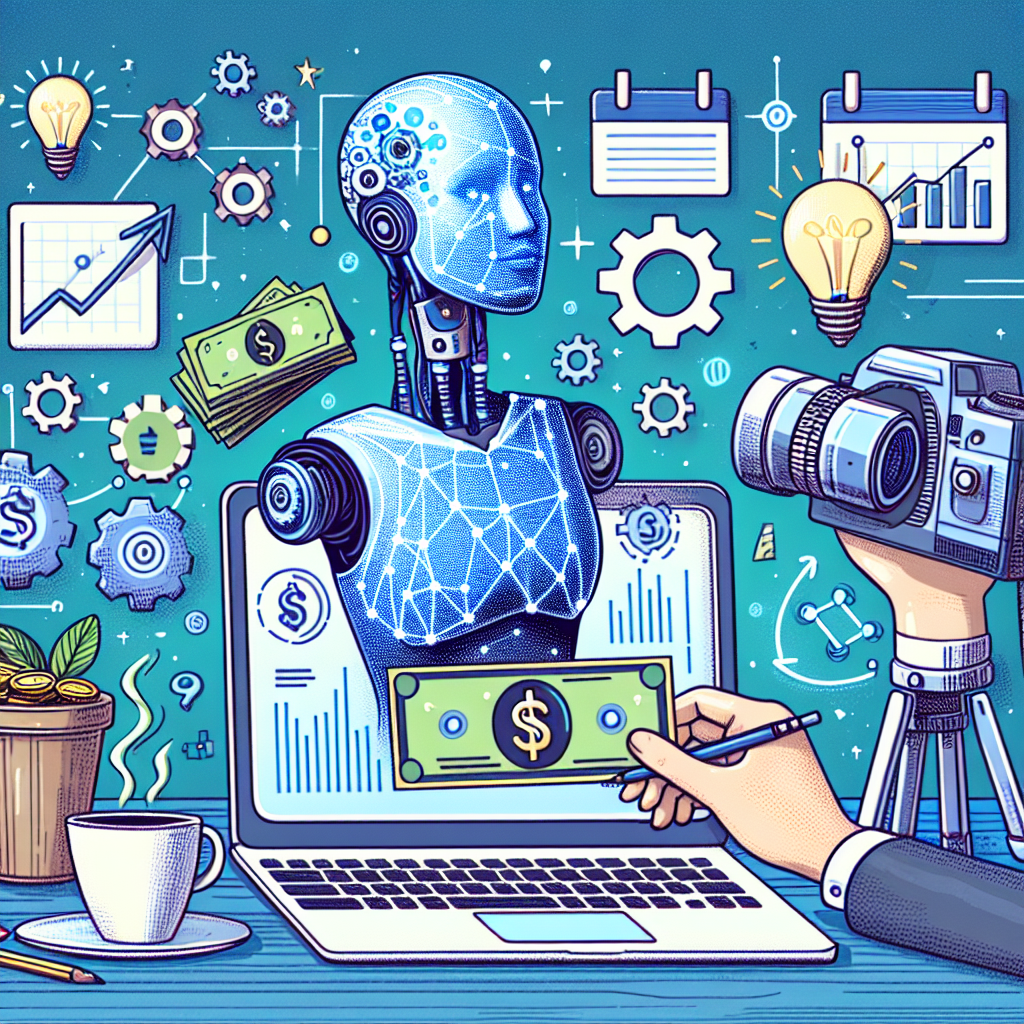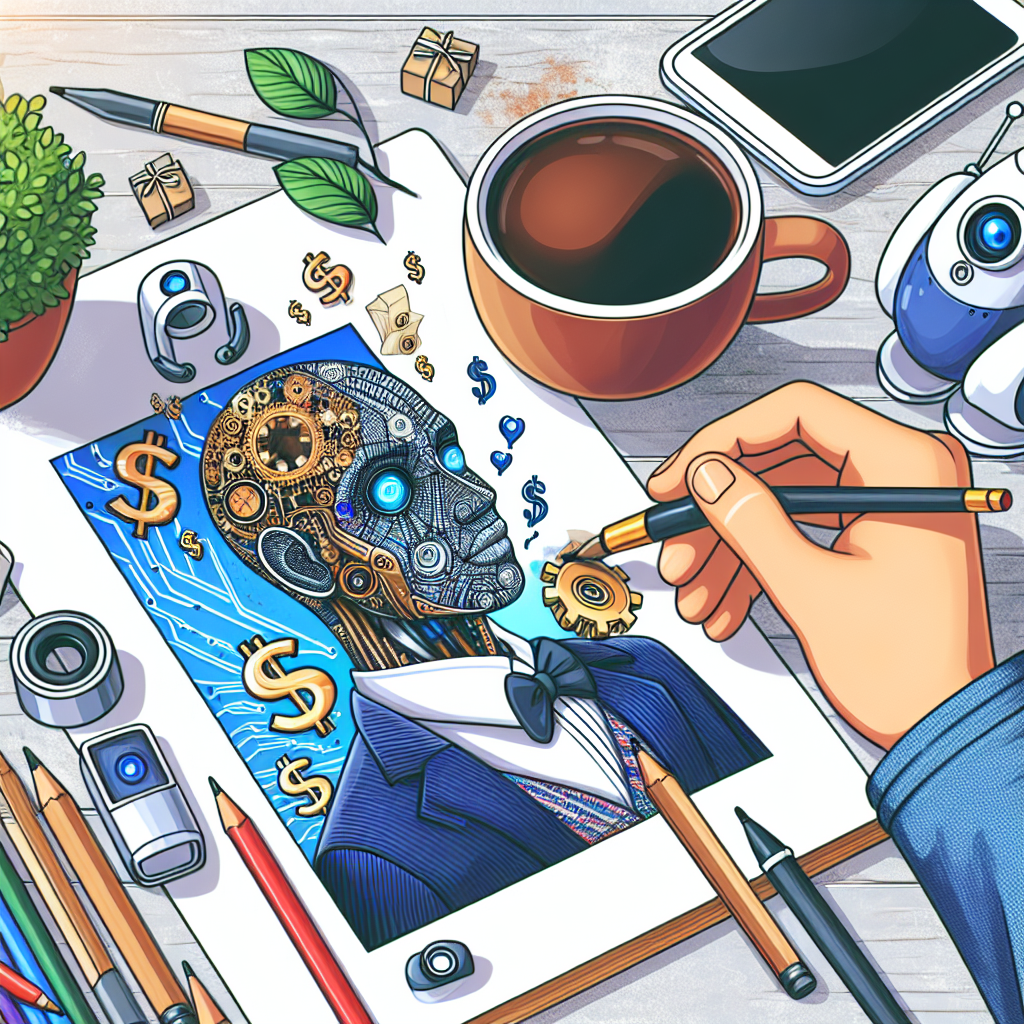-
Table of Contents
“解锁AI绘图财富密码:2025年最具潜力的副业指南”
Introduction
《AI绘图赚钱指南:2025年最具潜力的副业之一》介绍了如何利用人工智能技术在绘图领域实现盈利。随着AI技术的迅猛发展,越来越多的创作者开始借助AI工具进行艺术创作,从而节省时间和提高效率。本指南将深入探讨AI绘图的基本原理、市场需求以及如何通过AI绘图开辟新的收入来源。无论是业余爱好者还是专业艺术家,都可以通过本指南掌握AI绘图的技巧和策略,抓住这一新兴领域的商机,实现经济收益。
Maximizing Earnings: Strategies For Profiting From AI Art In 2025
In the rapidly evolving landscape of 2025, artificial intelligence has become an integral part of various industries, with AI-generated art emerging as a particularly lucrative avenue. As technology continues to advance, the potential for profiting from AI art has grown exponentially, making it one of the most promising side hustles of the year. To maximize earnings in this burgeoning field, it is essential to adopt strategic approaches that leverage both creativity and technology.
Firstly, understanding the tools at your disposal is crucial. AI art platforms have become increasingly sophisticated, offering a range of features that allow for the creation of unique and compelling artworks. Familiarizing yourself with these tools, such as generative adversarial networks (GANs) and neural style transfer, can significantly enhance the quality of your creations. By mastering these technologies, you can produce art that stands out in a crowded market, thereby increasing its value and appeal to potential buyers.
Moreover, diversifying your portfolio is a key strategy for maximizing earnings. While it may be tempting to focus on a specific style or theme, exploring a variety of artistic expressions can attract a broader audience. This not only increases the likelihood of sales but also establishes you as a versatile artist capable of catering to different tastes and preferences. Additionally, offering a range of products, from digital prints to physical merchandise, can further expand your revenue streams.
In addition to diversifying your portfolio, building a strong online presence is essential for reaching potential buyers. Social media platforms, online galleries, and digital marketplaces provide excellent opportunities to showcase your work to a global audience. By actively engaging with these platforms, you can build a following and establish a brand that resonates with art enthusiasts and collectors alike. Furthermore, utilizing search engine optimization (SEO) techniques can enhance the visibility of your online portfolio, making it easier for potential buyers to discover your work.
Networking within the AI art community is another effective strategy for maximizing earnings. By connecting with other artists, developers, and industry professionals, you can gain valuable insights into market trends and emerging opportunities. Collaborations and partnerships can also lead to new projects and revenue streams, further enhancing your earning potential. Attending industry events, participating in online forums, and joining professional organizations are excellent ways to build these connections.
Pricing your artwork appropriately is also critical to maximizing earnings. While it is important to ensure that your prices reflect the quality and uniqueness of your work, it is equally important to remain competitive within the market. Conducting thorough research on current market trends and pricing strategies can help you determine the optimal price point for your creations. Offering limited editions or exclusive pieces can also create a sense of scarcity, driving up demand and allowing for higher pricing.
Finally, staying informed about technological advancements and market trends is essential for long-term success in the AI art industry. As technology continues to evolve, new tools and techniques will emerge, offering fresh opportunities for innovation and creativity. By remaining adaptable and open to change, you can continue to produce cutting-edge art that captivates audiences and maximizes your earning potential.
In conclusion, profiting from AI art in 2025 requires a combination of technical proficiency, creative exploration, and strategic marketing. By leveraging the latest tools, diversifying your offerings, building a strong online presence, networking within the community, pricing your work appropriately, and staying informed about industry trends, you can position yourself for success in this exciting and dynamic field.
Top Platforms For Selling AI-Generated Art: A 2025 Guide

In the rapidly evolving digital landscape of 2025, AI-generated art has emerged as a lucrative avenue for creative entrepreneurs. As artificial intelligence continues to advance, artists and technologists alike are harnessing its capabilities to produce stunning visual works. This burgeoning field offers a unique opportunity for individuals to monetize their creativity, and understanding the top platforms for selling AI-generated art is crucial for success in this competitive market.
To begin with, one of the most prominent platforms for selling AI-generated art is ArtStation. Known for its robust community of digital artists, ArtStation has embraced AI art by providing dedicated spaces for creators to showcase and sell their work. The platform’s user-friendly interface and extensive reach make it an ideal choice for artists looking to gain visibility and connect with potential buyers. Moreover, ArtStation’s integration with social media channels allows artists to promote their work effectively, thereby increasing their chances of making sales.
In addition to ArtStation, Etsy has also become a popular marketplace for AI-generated art. Traditionally known for handmade and vintage items, Etsy has expanded its offerings to include digital art, providing a platform for AI artists to reach a diverse audience. The platform’s emphasis on unique and personalized items aligns well with the innovative nature of AI art, making it an attractive option for creators. Furthermore, Etsy’s global reach and established customer base offer significant advantages for artists seeking to expand their market presence.
Another noteworthy platform is DeviantArt, which has long been a hub for digital artists. With the rise of AI-generated art, DeviantArt has adapted by offering tools and resources specifically tailored to this new form of creativity. The platform’s community-driven approach fosters collaboration and feedback, enabling artists to refine their work and engage with a supportive audience. Additionally, DeviantArt’s print-on-demand service allows artists to sell physical copies of their AI-generated art, providing an additional revenue stream.
Transitioning to more specialized platforms, SuperRare stands out as a leading marketplace for digital art, particularly in the realm of non-fungible tokens (NFTs). As NFTs continue to gain traction, SuperRare offers a unique opportunity for AI artists to tokenize their work and sell it to collectors worldwide. The platform’s focus on high-quality, curated art ensures that only the best pieces are featured, enhancing the value and prestige of the artwork. This exclusivity, combined with the growing interest in NFTs, makes SuperRare an appealing choice for artists looking to capitalize on the digital art revolution.
Furthermore, Foundation is another platform that has gained prominence in the NFT space. Known for its artist-friendly approach, Foundation provides a seamless experience for creators to mint and sell their AI-generated art as NFTs. The platform’s emphasis on community and collaboration encourages artists to connect with one another, fostering a vibrant ecosystem of creativity and innovation. By leveraging the power of blockchain technology, Foundation offers artists a secure and transparent way to monetize their work.
In conclusion, the landscape for selling AI-generated art in 2025 is rich with opportunities. Platforms like ArtStation, Etsy, DeviantArt, SuperRare, and Foundation each offer unique advantages for artists seeking to monetize their creations. By understanding the strengths of each platform and strategically positioning their work, AI artists can successfully navigate this dynamic market and unlock the full potential of their creative endeavors. As the intersection of art and technology continues to evolve, those who embrace these platforms will be well-positioned to thrive in the digital art economy.
Future Trends In AI Art Monetization: Opportunities And Challenges In 2025
As we approach 2025, the landscape of artificial intelligence (AI) art monetization is rapidly evolving, presenting both exciting opportunities and notable challenges. The integration of AI in the creative process has opened new avenues for artists and entrepreneurs alike, transforming AI-generated art into one of the most promising side hustles of the future. This shift is driven by advancements in machine learning algorithms, which have significantly enhanced the quality and diversity of AI-generated artworks, making them increasingly appealing to a broader audience.
One of the primary opportunities in AI art monetization lies in the democratization of art creation. AI tools have lowered the barriers to entry for aspiring artists, enabling individuals without formal training to produce high-quality art. This accessibility has expanded the pool of creators, fostering a vibrant and diverse community that is continually pushing the boundaries of what AI art can achieve. As a result, marketplaces for AI-generated art are flourishing, providing artists with platforms to showcase and sell their work to a global audience. These platforms not only facilitate transactions but also offer artists exposure to potential buyers, collectors, and collaborators.
Moreover, the rise of non-fungible tokens (NFTs) has further revolutionized the monetization of AI art. NFTs provide a mechanism for artists to authenticate and sell their digital creations as unique assets, ensuring that they retain ownership and control over their work. This has led to a surge in demand for AI-generated art, as collectors and investors seek to acquire distinctive pieces that hold both aesthetic and technological value. The NFT market has thus become a lucrative avenue for artists to monetize their AI-generated creations, with some pieces fetching substantial sums at auction.
However, alongside these opportunities, there are significant challenges that must be addressed. One of the foremost concerns is the issue of copyright and intellectual property rights. As AI-generated art becomes more prevalent, questions arise regarding the ownership of these creations. Determining who holds the rights to AI-generated art—whether it is the developer of the AI, the user who inputs the data, or the AI itself—remains a complex legal and ethical dilemma. This uncertainty can hinder artists’ ability to protect and profit from their work, necessitating the development of clear legal frameworks to address these issues.
Additionally, the proliferation of AI-generated art raises questions about authenticity and originality. As AI tools become more sophisticated, distinguishing between human-created and AI-generated art becomes increasingly challenging. This blurring of lines may lead to skepticism among buyers and collectors, potentially impacting the perceived value of AI art. Artists and platforms must therefore strive to maintain transparency about the role of AI in the creative process, ensuring that consumers are informed and confident in their purchases.
In conclusion, the future of AI art monetization in 2025 is characterized by a dynamic interplay of opportunities and challenges. The advancements in AI technology and the rise of NFTs have created a fertile ground for artists to explore new creative possibilities and revenue streams. However, addressing the legal, ethical, and perceptual challenges associated with AI-generated art is crucial to sustaining its growth and acceptance in the art world. As we navigate this evolving landscape, it is essential for artists, developers, and policymakers to collaborate in shaping a future where AI art can thrive as a legitimate and valued form of creative expression.
Conclusion
《AI绘图赚钱指南:2025年最具潜力的副业之一》总结指出,随着人工智能技术的不断进步,AI绘图已成为一个具有巨大潜力的领域。通过掌握AI绘图工具和技术,个人可以在多个行业中找到商机,如广告、设计、影视制作等。AI绘图不仅提高了创作效率,还降低了进入门槛,使更多人能够参与其中。未来几年,随着市场需求的增长和技术的进一步成熟,AI绘图有望成为最具吸引力和盈利能力的副业之一。
